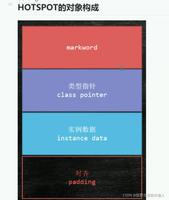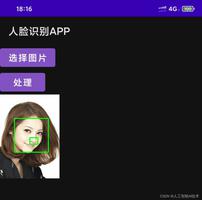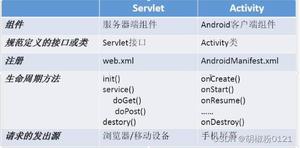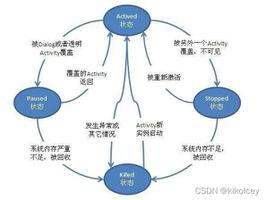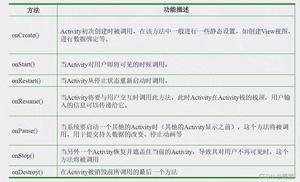【安卓】Android Jetpack架构组件(四)之LiveData
一、 LiveData简介
LiveData是Jetpack架构组件Lifecycle 库的一部分,是一个可感知生命周期的可观察容器类 (Observable)。与常规的可观察类不同,LiveData 具有生命周期感知能力,这意味着它具有感知应用组件(如 Activity、Fragment 或 Service)的生命周期的能力,并且LiveData仅更新处于活跃生命周期状态的应用组件观察者。
因此,LiveData具有如下一些特效。
- LiveData是一个持有数据的容器类,它持有的数据是可以被观察者订阅的,当数据发生变化时会通知观察者,观察者可以是 Activity、Fragment、Service 等对象。
- LiveData 具有感知观察者的生命周期能力,并且只有当观察者处于激活状态(STARTED、RESUMED)才会接收到数据更新的通知,在未激活时会自动解除注册观察者,以降低内存泄漏的风险。
- 使用 LiveData 保存数据时,由于数据和组件是分离的,所以当组件被销毁时可以保证数据不会丢失。
因此,我们认为LiveData就是一个数据容器,它负责将数据包裹起来,使数据成为被观察者,当数据发生变化时,LiveData会通知观察者以便观察者做出响应。
那相比其他的一些观察者技术,如RxJava什么的,LiveData有哪些优势吗,下面是官方给出的一些优点列举。
- 确保 UI 界面始终和数据状态保持一致。
- 不会发生内存泄漏。观察者绑定到 Lifecycle 对象并在其相关生命周期 destroyed 后自行解除绑定。
- 不会因为 Activity 停止而发生奔溃。如 Activity执行finish方法后,它就不会收到任何LiveData 事件。
- 不再需要手动处理生命周期。UI 组件只需观察相关数据,不需要停止或恢复观察,LiveData 会自动管理这些操作,因为 LiveData 可以感知生命周期状态的更改。
- 数据始终保持最新状态。在生命周期从非激活状态变为激活状态,始终保持最新数据,如后台 Activity 在返回到前台后可以立即收到数据的最新状态。
- 适当的配置更改。当配置发生更改(如屏幕旋转)而重建 Activity / Fragment,它会立即收到最新的可用数据。
- 资源共享。LiveData 很适合用于组件(Activity / Fragment)之间的通信,以及共享数据资源。
二、 LiveData与ViewModel的关系
在Jetpack架构中,ViewModel的主要作用是存储各种数据,当然,我们也可以在ViewModel中处理一些数据逻辑。例如,我们可以在ViewModel中对加载的数据进行某些加工操作。
而对页面来说,它并不需要关心ViewModel中的数据逻辑,它只关心需要展示的数据是什么,并且在数据发生变化时通知页面数据的变化并做出相应的更新。而LiveData的作用就是包装ViewModel中数据,并让被观察者能够观察数据的变化。下图是官方Jetpack架构的示意图。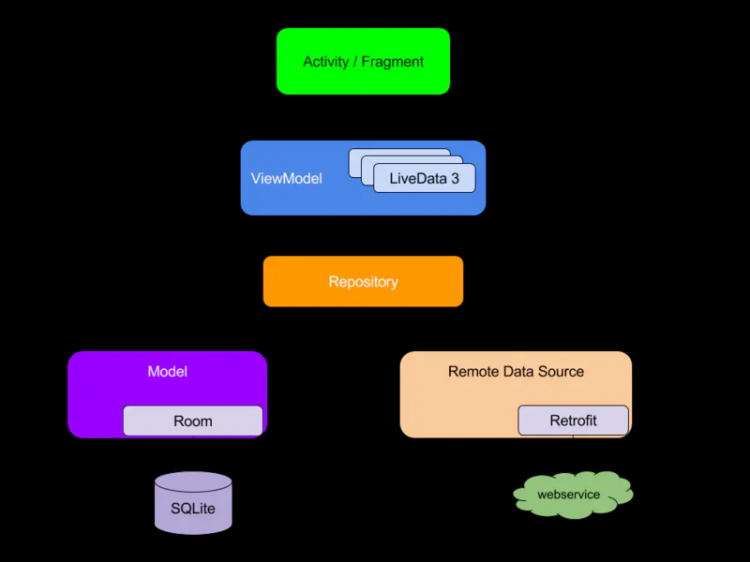
三、 LiveData的基本使用
3.1 使用步骤
LiveData的使用比较简单,主要会涉及以下几个步骤:
- 创建 LiveData 实例以存储某种类型的数据,通常在ViewModel中完成。
- 定义一个具有onChanged()方法的Observer对象,当LiveData持有数据发生变化时回调该方法。通常,我们可以在UI控制器类中创建该Observer对象,如Activity或Fragment。
- 通过使用observe()方法将上述的LiveData对象和Observer对象关联在一起。这样Observer对象就与LiveData产生了订阅关系,当LiveData数据发生变化时通知,而在Observer更新数据,所以Observer通常是Activity和Fragment。
从上述步骤可以看出,LiveData使用了观察者模式,观察者通常是UI控制器,如Activity或Fragment,而被观察者则是LiveData包谷的数据对象, 当LiveData对象持有数据发生变化,会通知对它订阅的所有处于活跃状态的订阅者。
3.2 LiveData使用示例
3.2.1 创建 LiveData 对象
LiveData是一种可用于任何数据的封装容器,其中包括可实现 Collections 的对象,如 List。LiveData 对象通常存储在 ViewModel 对象中,并可通过 getter 方法进行访问,如下所示。
public class NameViewModel extends ViewModel {private MutableLiveData<String> name;
public MutableLiveData<String> getName() {
if (name == null) {
name = new MutableLiveData<String>();
}
return name;
}
}
3.2.2 观察 LiveData 对象
在大多数情况下,我们可以应用组件的 onCreate() 方法中开始观察 LiveData 对象。并且,LiveData 仅在数据发生更改时才发送更新,并且仅发送给活跃观察者,如下所示。
public class MainActivity extends AppCompatActivity {private static final String TAG = "MainActivity";
private NameViewModel model;
private TextView nameTV;
@Override
protected void onCreate(Bundle savedInstanceState) {
super.onCreate(savedInstanceState);
setContentView(R.layout.activity_main);
nameTV=findViewById(R.id.nameTV);
model = new ViewModelProvider(this).get(NameViewModel.class);
final Observer<String> nameObserver = new Observer<String>() {
@Override
public void onChanged(@Nullable final String newName) {
nameTV.setText(newName);
}
};
model.getName().observe(this, nameObserver);
}
}
当我们传递 nameObserver 参数的情况下调用 observe() 后,系统会立即调用 onChanged(),从而提供 mCurrentName 中存储的最新值,如果 LiveData 对象尚未在 mCurrentName 中设置值,则不会调用 onChanged()。事实上,最简单的LiveData使用方法是MutableLiveData,如下所示。
public class MainActivity extends AppCompatActivity {private static final String TAG="MainActivity";
@Override
protected void onCreate(Bundle savedInstanceState) {
super.onCreate(savedInstanceState);
setContentView(R.layout.activity_main);
MutableLiveData<String> mutableLiveData = new MutableLiveData<>();
mutableLiveData.observe(this, new Observer<String>() {
@Override
public void onChanged(@Nullable final String s) {
Log.d(TAG, "onChanged:"+s);
}
});
mutableLiveData.postValue("Android应用开发实战");
}
}
3.2.3 更新 LiveData 对象
LiveData 本身没有公开可用的方法来更新存储的数据,如果需要修改LiveData的数据,可以使用MutableLiveData 类将公开 setValue(T) 和 postValue(T) 方法。通常情况下会在 ViewModel 中使用 MutableLiveData,然后 ViewModel 只会向观察者公开不可变的 LiveData 对象,如下所示。
button.setOnClickListener(new OnClickListener() {@Override
public void onClick(View v) {
String anotherName = "John Doe";
model.getCurrentName().setValue(anotherName);
}
});
3.2.4 扩展 LiveData
如果观察者的生命周期处于 STARTED 或 RESUMED 状态,则 LiveData 会认为该观察者处于活跃状态。以下示例代码说明了如何扩展 LiveData 类。
public class StockLiveData extends LiveData<BigDecimal> {private StockManager stockManager;
private SimplePriceListener listener = new SimplePriceListener() {
@Override
public void onPriceChanged(BigDecimal price) {
setValue(price);
}
};
public StockLiveData(String symbol) {
stockManager = new StockManager(symbol);
}
@Override
protected void onActive() {
stockManager.requestPriceUpdates(listener);
}
@Override
protected void onInactive() {
stockManager.removeUpdates(listener);
}
}
在上面的示例中,我们首先建立一个StockLiveData并继承自LiveData,并重写了onActive和onInactive两个重要方法。
onActivite():当有活跃状态的订阅者订阅LiveData时会回调该方法,意味着需要在这里监听数据的变化。
onInactive():当没有活跃状态的订阅者订阅LiveData时会回调该方法,此时没有必要保持StockManage服务象的连接。
setValue():注意到value=price这里是调用了setValue(price)方法,通过该方法更新LiveData的值,进而通知处于活跃状态的订阅者。
此时,LiveData会认为订阅者的生命周期处于STARTED或RESUMED状态时,该订阅者是活跃的,那么如何使用 StockLiveData 类呢,如下所示。
public class MyFragment extends Fragment {@Override
public void onViewCreated(@NonNull View view, @Nullable Bundle savedInstanceState) {
super.onViewCreated(view, savedInstanceState);
LiveData<BigDecimal> myPriceListener = ...;
myPriceListener.observe(getViewLifeycleOwner(), price -> {
// Update the UI.
});
}
}
以Fragment作LifecycleOwner的实例传递到observer()方法中,这样就将Observer绑定到拥有生命周期的拥有者。由于LiveData可以在多个Activity、Fragment和Service中使用,所以可以创建单例模式。
public class StockLiveData extends LiveData<BigDecimal> {private static StockLiveData sInstance;
private StockManager stockManager;
private SimplePriceListener listener = new SimplePriceListener() {
@Override
public void onPriceChanged(BigDecimal price) {
setValue(price);
}
};
@MainThread
public static StockLiveData get(String symbol) {
if (sInstance == null) {
sInstance = new StockLiveData(symbol);
}
return sInstance;
}
private StockLiveData(String symbol) {
stockManager = new StockManager(symbol);
}
@Override
protected void onActive() {
stockManager.requestPriceUpdates(listener);
}
@Override
protected void onInactive() {
stockManager.removeUpdates(listener);
}
}
然后,我们就可以在 Fragment 中使用它,如下所示。
public class MyFragment extends Fragment {@Override
public void onViewCreated(@NonNull View view, @Nullable Bundle savedInstanceState) {
super.onViewCreated(view, savedInstanceState);
StockLiveData.get(symbol).observe(getViewLifecycleOwner(), price -> {
// Update the UI.
});
}
}
3.2.5 转换 LiveData
有时候,我们希望在把数据分发给观察者之前进行一些处理,或者返回一个基于已有值的LiveData对象的另外一个LiveData对象,此时就会用到 Transformations类。转化LiveData时需要用到Transformations.map()和Transformations.switchMap()等方法。
Transformations.map()
例如,下面是使用Transformations.map()方法处理LiveData存储的数据,然后将其传递给下游的示例代码。
LiveData<User> userLiveData = ...;LiveData<String> userName = Transformations.map(userLiveData, user -> {
user.name + " " + user.lastName
});
Transformations.switchMap()
使用Transformations.switchMap()方法同样可以改变LiveData下游的结果,但传递给switchMap()函数的必须是一个LiveData对象,如下所示。
private LiveData<User> getUser(String id) {...;
}
LiveData<String> userId = ...;
LiveData<User> user = Transformations.switchMap(userId, id -> getUser(id) );
不过,这种转换方式是惰性的,也就是只有Observer来订阅数据的时候,才会进行转换。因此,当在ViewModel中使用一个Lifecycle对象,这种转换是一种很好的解决方案。例如,假设您有一个界面组件,该组件接受地址并返回该地址的邮政编码,那么我们可以使用switchMap()方法进行转化。
class MyViewModel extends ViewModel {private final PostalCodeRepository repository;
private final MutableLiveData<String> addressInput = new MutableLiveData();
public final LiveData<String> postalCode =
Transformations.switchMap(addressInput, (address) -> {
return repository.getPostCode(address);
});
public MyViewModel(PostalCodeRepository repository) {
this.repository = repository
}
private void setInput(String address) {
addressInput.setValue(address);
}
}
四、LiveData工作原理
通过前面的介绍,我们知道LiveData是一个可观察的数据持有者,并且它是具有组件生命周期感知能力的,那它是如何观察组件生命周期变化的呢?同时,LiveData仅更新处于活跃生命周期状态的应用组件观察者,也即是说LiveData并不会通知所有的观察者,它只会通知处于活跃状态的观察者,那么它是如何做到这一点的呢?
LiveData生命周期变化观察
前面介绍LiveData用法的时候提到,首先,我们创建 LiveData 实例,然后调用LiveData的observe方法来注册观察者,将ViewModel和LiveData关联起来。observe()方法的源码如下。
@MainThreadpublic void observe(@NonNull LifecycleOwner owner, @NonNull Observer<? super T> observer) {
assertMainThread("observe");
if (owner.getLifecycle().getCurrentState() == DESTROYED) {
// ignore
return;
}
LifecycleBoundObserver wrapper = new LifecycleBoundObserver(owner, observer);
ObserverWrapper existing = mObservers.putIfAbsent(observer, wrapper);
if (existing != null && !existing.isAttachedTo(owner)) {
throw new IllegalArgumentException("Cannot add the same observer"
+ " with different lifecycles");
}
if (existing != null) {
return;
}
owner.getLifecycle().addObserver(wrapper);
}
可以发现,observe首先会判断组件当前的状态,如果状态为DESTROYED,那么直接return,这说明DESTROYED状态的组件是不允许注册的。然后,新建一个LifecycleBoundObserver包装类,将owner和observer传了进去。接下来,将observer和LifecycleBoundObserver存储到SafeIterableMap<Observer<? super T>, ObserverWrapper>mObservers中,注意,此处使用的是putIfAbsent方法,接下来对传入的值进行判断,如果传入key对应的value已经存在,就返回存在的value,不进行替换,如果不存在就添加key和value,返回null。
最后,通过owner.getLifecycle().addObserver()方法将LifecycleBoundObserver添加到Lifecycle中完成注册,这样处理之后LiveData就有了观察组件生命周期变化的能力。
LifecycleBoundObservers
LifecycleBoundObservers是LiveData的内部类,源码如下。
class LifecycleBoundObserver extends ObserverWrapper implements LifecycleEventObserver {@NonNull
final LifecycleOwner mOwner;
LifecycleBoundObserver(@NonNull LifecycleOwner owner, Observer<? super T> observer) {
super(observer);
mOwner = owner;
}
@Override
boolean shouldBeActive() {
return mOwner.getLifecycle().getCurrentState().isAtLeast(STARTED);
}
@Override
public void onStateChanged(@NonNull LifecycleOwner source,
@NonNull Lifecycle.Event event) {
if (mOwner.getLifecycle().getCurrentState() == DESTROYED) {
removeObserver(mObserver);
return;
}
activeStateChanged(shouldBeActive());
}
@Override
boolean isAttachedTo(LifecycleOwner owner) {
return mOwner == owner;
}
@Override
void detachObserver() {
mOwner.getLifecycle().removeObserver(this);
}
}
LifecycleBoundObserver实现了GenericLifecycleObserver接口,当组件状态发生变化时,会调用onStateChanged方法,当组件处于DESTROYED状态时,会调用removeObserver方法移除observer。
而LifecycleBoundObserver继承了ObserverWrapper类,需要重写shouldBeActive方法,用于判断当前传入的组件的状态是否是Active状态,即处于STARTED和RESUMED状态。
ObserverWrapper
ObserverWrapper是Observer的包装类,LiveData的生命周期状态监听activeStateChanged方法就定义在抽象类ObserverWrapper中,源码如下。
private abstract class ObserverWrapper {final Observer<? super T> mObserver;
boolean mActive;
int mLastVersion = START_VERSION;
ObserverWrapper(Observer<? super T> observer) {
mObserver = observer;
}
abstract boolean shouldBeActive();
boolean isAttachedTo(LifecycleOwner owner) {
return false;
}
void detachObserver() {
}
void activeStateChanged(boolean newActive) {
if (newActive == mActive) {
return;
}
mActive = newActive;
boolean wasInactive = LiveData.this.mActiveCount == 0;
LiveData.this.mActiveCount += mActive ? 1 : -1;
if (wasInactive && mActive) {
onActive();
}
if (LiveData.this.mActiveCount == 0 && !mActive) {
onInactive();
}
if (mActive) {
dispatchingValue(this);
}
}
}
activeStateChanged()方法会根据Active状态和处于Active状态的组件的数量,来对onActive方法和onInactive方法进行回调,我们可以使用这两个方法拓展LiveData对象。如果生命周期状态是Active状态,那么会调用dispatchingValue方法。
private void dispatchingValue(@Nullable ObserverWrapper initiator) {if (mDispatchingValue) {
mDispatchInvalidated = true;
return;
}
mDispatchingValue = true;
do {
mDispatchInvalidated = false;
if (initiator != null) {
considerNotify(initiator);
initiator = null;
} else {
for (Iterator<Map.Entry<Observer<? super T>, ObserverWrapper>> iterator =
mObservers.iteratorWithAdditions(); iterator.hasNext(); ) {
considerNotify(iterator.next().getValue());
if (mDispatchInvalidated) {
break;
}
}
}
} while (mDispatchInvalidated);
mDispatchingValue = false;
}
mDispatchingValue用于标记当前是否处于分发状态中,如果处于分发状态就会进行状态的分发,并最终调用considerNotify方法进行消息的分发,代码如下所示。
private void considerNotify(ObserverWrapper observer) {if (!observer.mActive) {
return;
}
if (!observer.shouldBeActive()) {
observer.activeStateChanged(false);
return;
}
if (observer.mLastVersion >= mVersion) {
return;
}
observer.mLastVersion = mVersion;
//noinspection unchecked
observer.mObserver.onChanged((T) mData);
}
considerNotify方法中做了多次的判断,首先,判断ObserverWrapper的mActive值如果不为true就直接return。然后,判断当前observer对应组件的状态是不是Active,如果不是就会再次调用activeStateChanged方法并传入false,其方法内部会再次判断是否执行onActive方法和onInactive方法回调。如果判断条件都满足就继续调用Observer的onChanged方法,这个方法正是使用LiveData的observe方法的回调。
以上是 【安卓】Android Jetpack架构组件(四)之LiveData 的全部内容, 来源链接: utcz.com/a/101191.html

